Everything You Need to Know About Airotor
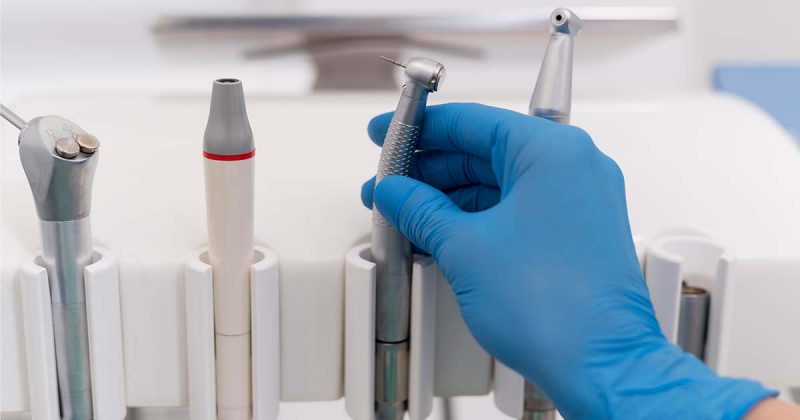
Everything You Need to Know About Airotor – A dentist’s daily practice is highly dependent on an essential extension of their arm: an Airotor, the heart of the daily dental practice. It is a critical tool that seamlessly combines speed and accuracy for procedures ranging from cavity preparation to major surgical extractions.
Selecting the right airotor is more than a technical choice; it ensures smooth workflow, optimal results, and long-term reliability. With countless options available, finding the perfect fit for your clinical needs can feel overwhelming.
In this guide, we’ll delve into how airotors work, explore their types, and highlight essential factors to consider when making your decision. By the end, you’ll be equipped with the knowledge to choose an airotor that enhances both your expertise and your patients’ experience.
How Airotor Technology Works?
Before introducing you to the types of airotors, let us first see how it works:

- Components of airotor: The head component of the airotor has the most important machinery for it to work, i.e., a turbine. This turbine consists of two miniature bearings, an impeller, and a spindle or chuck assembly for holding the bur.
- Introducing air: When the foot pedal is pressed to start the airotor, air gushes through the airline present at the back of the handpiece.
- Forcing air: This air moves into the head and is further forced into the impeller of the turbine, causing it to spin.
- Rotating impeller and chuck: The air thus moves around the turbine impeller, which is mounted on a spindle/chuck assembly, supported on either side by ball bearings and O rings.
- Bur Rotation: The bur attached to this assembly thus, allows the air energy to be productively converted into rotary motion for efficient cutting and polishing.
Types of Airotor and Factors to Consider Before Buying:
1. Speed:
Airotor Turbines rotate at speeds of about 400,000 rpm, faster than anything else on the planet. It is important to understand that not all these rotations reach the tooth. There are majorly two types of airotors based on speed, first are low-speed airotors with a speed of 80,000 rpm, operated by an inbuilt motor, which can be used for finishing and polishing procedures, to provide better control in delicate areas. Another type is, high-speed airotors which can rotate up to a speed of 4,00,000 rpm and are ideal for precise tooth cutting during a dental procedure.
2. Type of tubing connection:
Most often seen tubing connections in an airotor are two-hole types or four-hole types. The two-hole tubing ones are more common in India whereas the the four-hole ones are more common in Europe and US. Two-holed tubing airotors have a large hole for air and a smaller one for water.
Four-holed tubing airotors have an added advantage as these produce less noise because of the separate holes present for air intake and air escape. This feature not only helps in producing less noise but also allows the bur to halt faster. Additionally, these holes help in smooth water intake allowing the water jet to escape the airotor as a fine mist and not water droplets.
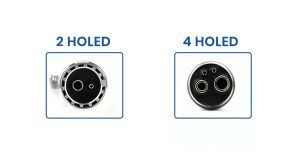
3. Ball bearing material:
It is one of the most important parts of an airotor for it to work efficiently. Ball bearings can be either made of stainless steel or ceramic. The ceramic ones are made up of ceramic on the outer side and have steel on the inside while the stainless steel ones are of steel on the outside and have inner rings of the same material.
Ceramic ball-bearing airotors are the most preferred ones because they run much cooler, are almost 60% lighter in weight than stainless steel-bearing airotors, and have a longer shelf life. Eventually, this contributes to better ergonomics, lesser hand strain, less centrifugal forces when operating at high speeds, and less noise production.
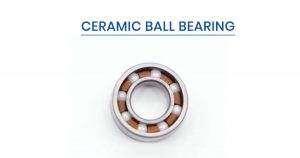
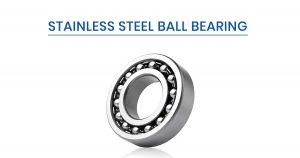
4. Depending on water spray:
A good water jet helps in efficient tooth preparation and removal of debris from the site of operation. Airotors can have single water spray, double water spray, or multiple ports for water spray(three or four).
Multiport water spray is preferred over single and double as it provides even distribution of the coolant water during dental procedures.
These water ports need to be rightly directed onto the operation site for adequate dissipation of heat and multiport water spray helps to achieve that much easily.
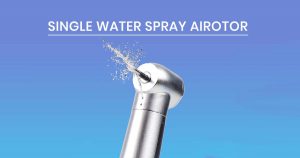
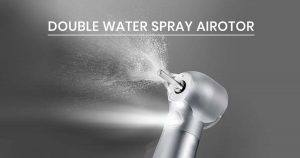
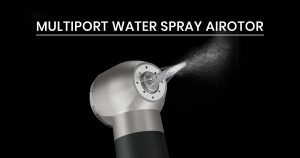
5. Bur retention mechanism:
There are two types of airotors depending on the bur retention mechanism, standard type or push button type. Standard types with a spindle and chuck are more secure but a lot of time is wasted during the change of burs while performing a dental procedure whereas the push button types are easy to assemble and use and time-saving but are not as secure as the spindle and chuck ones. Dentists can choose either of these as per their liking and preferred ease of use.
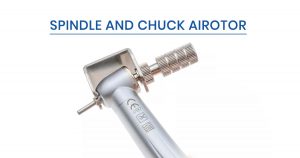
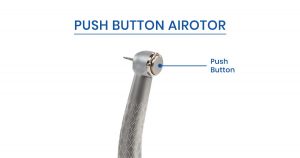
6. Head angulation:
Most handpieces are angled at 22.5 degrees helping the bur to be in line with the clinician’s line of site. This angulation of airotor is not useful for posterior teeth preparations and may cause hindrance during procedures. Nowadays, several airotors are present with different angulations up to a degree of 45, dentists can select one of these depending on their daily dental needs.
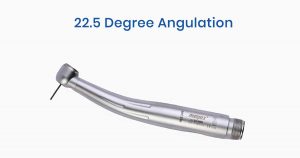
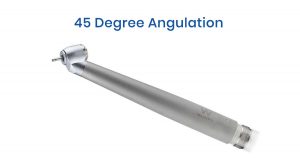
7. Light Source:
Airotors available in the market usually include two types, one, without any integrated source of light i.e., Non – LED type, and second, airotors with integrated source of light i.e., LED type.
This feature helps improve the operator’s visibility during procedures, reducing the time that is needed for continuous lamp adjustments during dental procedures. However, one can also choose the non–LED types, if they prefer the overhead light lamp only for its higher intensity and more coverage area.
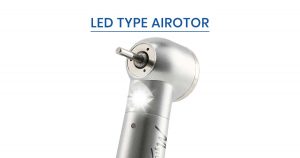
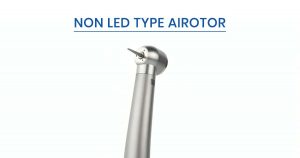
8. Head Size:
Different clinical needs require airotors with various head sizes to efficiently complete dental procedures. Typically, these are mini, standard, and large (super torque) head sizes.
The mini head size [10mm (diameter) x 10mm (height)] airotor helps in accessing the posterior parts of the oral cavity without hindrance and is especially useful for patients with restricted mouth openings. However, these airotors have a reduced cartridge lifespan due to their smaller head size.
A standard head size [11.2mm (diameter) x 13.14mm (height)] airotor provides an adequate rotational speed to ensure precise dental work. Its shorter head design offers a clear view of the operating area, but these airotors still require regular cartridge replacements.
A large head size /super torque [12.9mm (diameter) x 12.21mm (height)] airotor delivers superior torque and power output due to the incorporation of a larger turbine impeller. This design helps in reducing the time taken for tooth preparation during dental procedures. The larger turbine impeller also contributes to a longer lifespan of the airotor.
9. Outer body material:
The outer shell of the airotor dictates the durability and life span. The material used for making the airotor should be tough enough to survive the daily rather hourly, rigorous uses in a dental practice.
These can be made of either brass which is inexpensive but prone to easy denting or, stainless steel which is lighter and stronger than brass but has a higher manufacturing cost. Or, titanium which is 40% lighter than stainless steel, stronger than stainless steel, and has a much greater corrosion resistance than stainless steel but has higher manufacturer costs.
Other than the above-mentioned types and factors to look at before buying, another factor to check is the ergonomics of an airotor. The outer body design should be such that it prevents strain on the hand-wrist movements and should help in efficient cutting without much movement of the dentist’s hand during a procedure.
Advantages and Disadvantages of Airotor:
Air-driven handpieces or airotors have several advantages over electric handpieces. These are as follows:
- The speed of the airotor is much higher and helps in removing the tissue quickly with high precision and efficiency.
- These are relatively inexpensive to manufacture when compared to electric handpieces.
- Being lightweight and comfortable to use airotors reduces the dentist’s hand fatigue in his daily practice.
- Airotors provide tactile feedback which is not there in electric handpieces.
Disadvantages of Airotors:
- Heat generation by the high speed of airotors can cause thermal damage to the teeth.
- Vibrations can cause sensitivity in patients.
- Airotors are often noisy, thus uncomfortable to patients.
- Aerosols produced by airotors can be a cause of the spread of infection.
- Requires frequent turbine replacement and repairs.
Future Trends in Airotor Technology
- Ergonomics: Often neglected, but the most important factor to help increase a dentist’s efficiency is better hand-wrist control while holding an airotor. Newer designs can entail the creation of lightweight, enhanced grip styles and improved vibration-dampening systems.
- Noise reduction: Efforts are being made to reduce the noise production in the airotors to increase patient comfort. Cutting-edge sound-dampening materials can be used to achieve that but with this, there are chances of sacrificing the performance of airotor.
- Digital dentistry integration: Airotors may be connected to CAD/CAM systems to make tooth preparation and other cutting procedures more detailed and efficient.
- Irrigation systems: Better cooling systems or regularized water flow systems to improve the patient’s experience during a procedure and prevent any thermal damage are being tested.
- Infection control: With aerosols being the main reason for infection spread, newer technology is trying to integrate filter systems that reduce aerosol quantity and also disposable parts to decrease cross-contamination. ARV technology or anti-retraction valve handpieces protect from fluid retraction, from the oral cavity into the handpiece. Airotors without these valves will have the debris stored in the hoses and will release as aerosols when the same airotor is used for other patients. Shortly, handpieces with such technologies and features will be more in number contributing to better infection control.
Some suggestions for Best Airotors in the Dental Market:
Given its pivotal role, selecting the ideal airotor is crucial for ensuring optimal performance and patient care. With countless models available, navigating the options can be overwhelming. To simplify this decision-making process, we’ve curated a list of the top four airotors in the market. Following are some options for you to explore with their features and benefits enlisted, helping you make an informed choice that aligns with your clinical needs and preferences.
1. Waldent Tesla Airotor Standard Head (W-160)
- Material: High-quality Titanium
- Design: Feather-light, non-LED, autoclavable components
- Performance:
- Whisper-quiet operation
- Rotation range: 380,000 – 480,000 rpm
- Quattro water spray for excellent cooling
- Connection: Push-button chuck, Borden 2-hole connection
- Durability: Rust-free and heat-resistant
- Warranty: 2 years
2. NSK Pana Air FX Standard Head Push Button Airotor
- Material: Durable construction
- Design: Sleek, non-LED
- Performance:
- High-speed handpiece
- Rotation range: 350,000 – 450,000 rpm
- Powerful 20-watt motor
- Connection: Push-button chuck, 2-hole connection
- Warranty: 6 months
3. Being Foshan 45 Degree Airotor
- Material: Durable, lightweight design
- Design: Non-LED with a 45-degree angled head
- Performance:
- High-speed handpiece
- Rotation range: 380,000 – 450,000 rpm
- Less vibration and noise
- Connection: Push-button chuck
- Durability: Autoclavable handpiece
- Warranty: Not specified
4. Endoking Myrotor LED Airotor
- Material: Stainless steel, corrosion-resistant build
- Design: Small, lightweight, with LED illumination, autoclavable
- Ball bearing: Ceramic
- Performance:
- High-speed handpiece
- Rotation range: Not specified
- Less vibration and heat generation
- 3-hole water jet spray for effective cooling
- Connection: Push-button chuck, Borden 2-hole connection
- Warranty: 6 months
Conclusion:
Choosing the right Airotor isn’t just about picking dental equipment; it’s about selecting a companion that complements your skills and enhances the quality of care you provide to your patients. With so many factors to consider—from speed and tubing connections to ergonomics and noise reduction—your decision should align with your unique clinical needs and preferences.
Remember, the ideal Airotor balances performance, comfort, and durability, ensuring that every procedure you perform is precise, efficient, and as stress-free as possible for both you and your patients. Investing in the right technology is not just an upgrade for your practice but also a commitment to delivering the best dental care. Take your time, research well, and choose wisely from India’s best online dental store – DentalKart because you and your patients deserve nothing less!

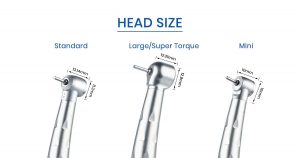
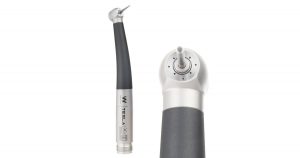
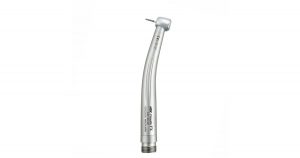
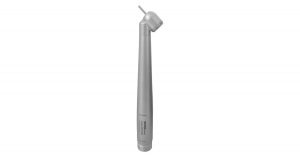
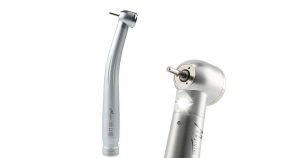
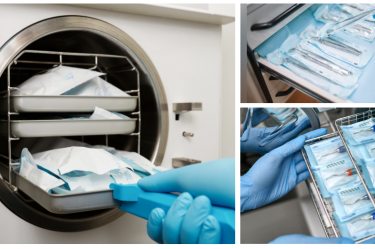
No Comment